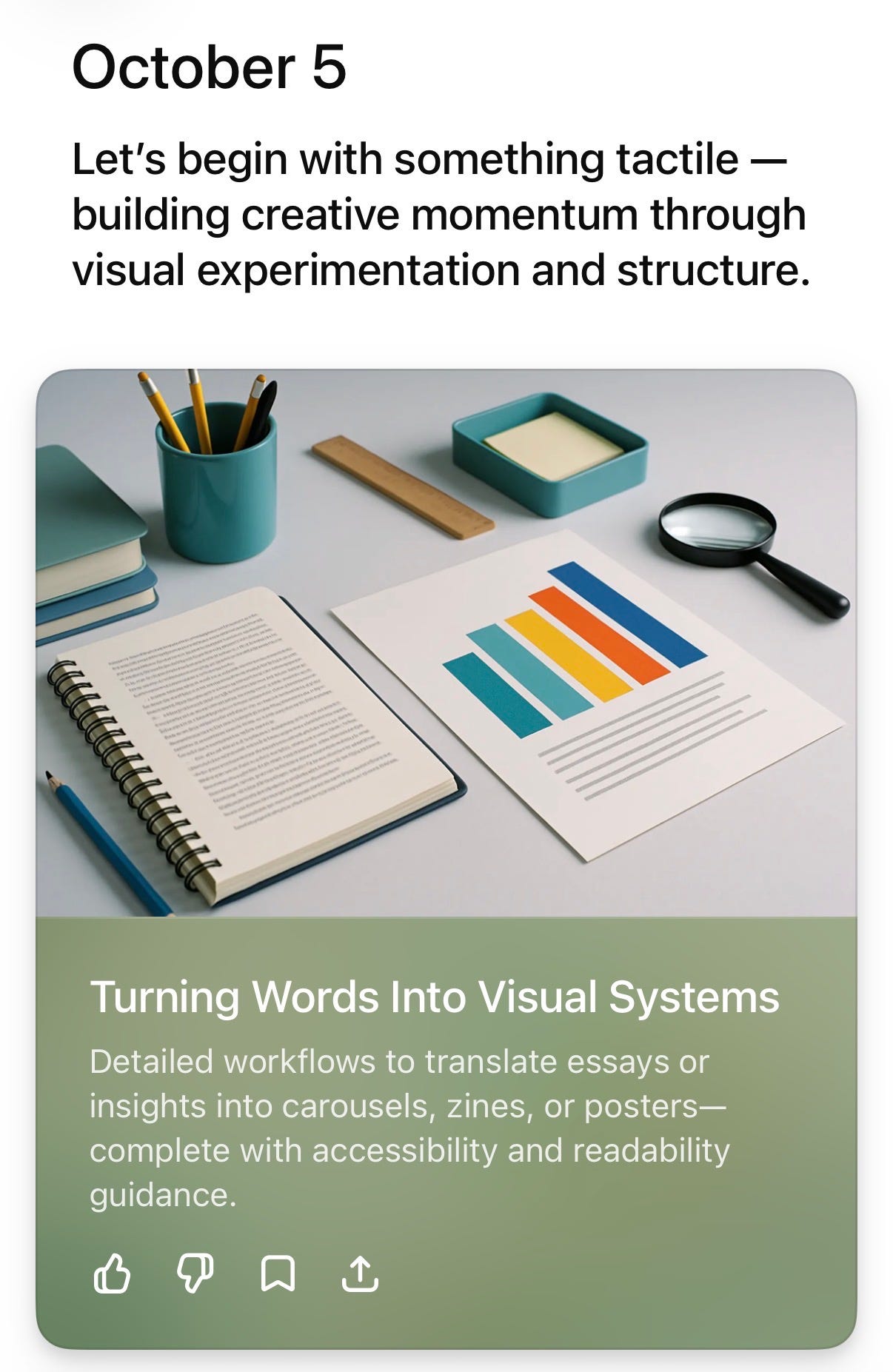What my pulse feed looked like on Sunday.
I’ve been experimenting with ChatGPT’s new Pulse feature — and it’s one of those upgrades that feels small at first glance but quietly rewires how you work with AI. In short: Pulse turns ChatGPT from a reactive tool into a proactive partner. And I’m already noticing new sparks in my design, writing, and idea-generation workflows.
What Is Pulse
Pulse is a new capability in ChatGPT (currently in preview for Pro users on mobile) designed to greet you each morning with a personalized feed of insights. Instead of waiting for you to ask a question, ChatGPT does a kind of asynchronous research overnight — drawing on your chat history, memory, and optional app connections (like your calendar or email) — to surface 5–10 cards of ideas, prompts, or reminders.
As Ars Technica explains, “ChatGPT Pulse works by analyzing a user’s chat history, saved preferences, and optional connections to Gmail and Google Calendar each night. The next morning, users receive visual ‘cards’ containing updates on topics the model determines are relevant — such as project follow-ups, dinner suggestions, or travel recommendations. Users can provide feedback through thumbs-up or -down ratings and request specific topics through a ‘curate’ button.”
In essence, Pulse flips the dynamic. Rather than you searching for information and ChatGPT responding, it anticipates what you might want to explore next. It’s the AI-powered feed that feels more like a built-in muse — one that works while you sleep and nudges you toward ideas you might not have thought to ask for.
If you have ChatGPT Pro on mobile (iOS or Android), you’ll find a new “Pulse” tab in the latest version of the app.
How I’m Using Pulse (and Why I’m Excited)
Since I started with Pulse, I’ve watched it inspire and shape parts of my work I wouldn’t normally touch first thing in the morning.
🎨 Design ideas (for Panic Responsibly):
I told Pulse I was interested in color trends (especially Pantone palettes), poster and visual experiments, and combining text with imagery. The next day, it gave me insights on Pantone’s 2025 color forecasts along with links to explore further. It’s become a morning moodboard that evolves with me.
✍️ Writing and creativity exercises:
Sometimes a card appears with a writing prompt — “Here’s an exercise based on the theme of silence or negative space.” Tap in, and it expands into a few micro-prompts. It feels like having a pocket-sized creative coach who knows exactly when I need a nudge.
🌀 Cross-disciplinary mashups:
Because I often ask for both visual and textual ideas, Pulse occasionally gives me hybrid prompts like: “What if you made a micro-dialogue layered over an image gradient?” or “Try animating a sticker you’ve already made into a short looping visual.”
One of my favorite moments: I once designed a playful sticker around the phrase Freeze Peach (an autocorrect slip from “free speech”). Pulse remembered and offered ideas for scaling it — from merch drops to animation treatments and typography experiments.
💼 Portfolio and consulting explorations:
Lately I’ve been reflecting on how to evolve my work into a hybrid creative-consulting model. One morning, Pulse surfaced several case studies of people who blend design and strategy — visual identity meets coaching, storytelling meets systems thinking. It’s become fuel for how I think about the next iteration of my portfolio life.
Where This Might Be Headed
Pulse is still new — and I’m still figuring out how to curate it — but it feels like a glimpse into the next era of the recommendation engine. Instead of a single algorithm deciding what content performs best for the masses, it’s a personalized system that learns what helps you think better.
I’m excited to keep experimenting with it alongside Agent Mode, which allows for even more autonomy in how AI assists with research and execution. Together, these features point toward something bigger: a more ambient, anticipatory AI that situates itself in your ongoing interests and gently pushes you forward.
Having a morning nudge from an AI that already “knows” your creative rhythms feels like the next evolution of how we’ll work — and maybe even how we’ll imagine.



